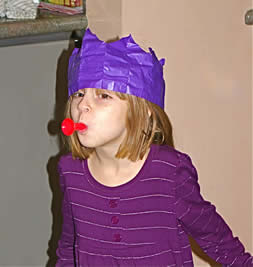Nancy Burke
Rhiannon is five. She has rheumatoid arthritis. Every Monday she gets an injection of an anti-inflammatory drug, and she doesn’t like it! During her Christmas visit to see “Nana” (her nickname for me, her grandmother), there were three Mondays. Katy, Rhiannon’s mother, had requested that “Nana” give her the injections. It’s been a long, long time since Nana’s injection days, but a mental review of the process and a few minutes with the trusty orange seemed adequate. In the old days, before the advent of high tech nursing labs, we used an orange to practice giving injections. When we had mastered the orange, we got to practice on each other.
The first Monday, things went pretty well except for a request: “Nana, do it faster.” The second Monday, however, was extremely difficult for both Rhiannon and “Nana.” By the end, we were both in tears.
Something had to change for both our sakes. After some thought, I settled on some guided imagery and relaxation techniques. We talked about giving her control over the process; we practiced deep breathing for three days. We visualized safe spaces, ideas for distraction, and started a journal. Now, my idea of a safe space does not include a Disneyland ride, nor is a computer jigsaw puzzle a distraction. They were, however, Rhiannon’s choices.
The third Monday was magical. Rhiannon practiced the breathing for a few minutes and then chose to do her Christmas ECard jigsaw puzzle while sitting on her mother’s lap. She wasn’t even aware of the injection. Afterwards, she dictated her journal entry. There are some charming journals for small children on the market. We found one that consisted of 20 pages of recycled paper with a cover made of an old Fruit Loops box.

Rhiannon then flew back home to California where she resumed the Monday injections and periodic blood draws, at the doctor’s office. Our third Monday, however, had transformed her Monday visits to the doctor. Rhiannon now chooses her method of distraction—a story, an activity, breathing, and imagery—and has “taught” the nurse to respect her choices. In fact, the nurse has become a champion of the process.
The journaling has continued. After two or three weeks, Rhiannon’s mother decided to learn to give the injections. Eliminating the anticipatory anxiety of going to the hospital, with the waiting and having multiple providers et cetera, seemed like a very good idea. After the first day with her mother, Rhiannon wrote: “Mommy needs to be faster too, but it’s okay, Mommy, Nana learned to do it better and you will too.”
In addition to making the weekly injections more pleasant for everyone, these simple activities have provided opportunities to talk with her about the disease and address some of her childhood guilt about her condition. For instance, jumping off the bed is not allowed in her house; so in five-year-old fashion, Rhiannon presumed that her violation of the rule caused the sore knees and, thus, the shots. “It’s all my fault,” she lamented. The journaling has provided an opportunity to clarify her feelings and then to concretize and visualize them through her artwork.
Too often we pay lip service to the strength and importance of the relationship between body and mind, but fail to employ this knowledge to its potential. After all, poetry, art, literature, music, dance, drama, and all art forms take advantage of that relationship. We see, hear, touch, smell and taste, and then we create. Whether it is a poem or a book or a song or a new recipe for bread pudding, the catalyst is the interaction between mind and body.
Fifteen years ago, while having radiation every day for six weeks, I visualized the little “beads of radiation” going directly to the cancer and blasting it off the map and out of my body. Did that cure the cancer? No. Did it make me feel more powerful? Yes!
Did Rhiannon’s “ride” on the Disneyland Mulholland Madness while she was getting her “shot” make the pain go away? No, not really. Did it make her feel more powerful? Yes!
Rhiannon is only five but she has already internalized powerful lessons about the body’s potential to adapt and the mind’s agility with transcendence. Not just grandmothers, but all of us stand to learn much from the imagination and courage and honesty of children.
As healthcare providers, we have myriad opportunities to help our clients, no matter what their age, use the power and creativity of their mind to balance whatever pain and discomfort the body experiences. The key to taking advantage of these opportunities is to stop and see, hear, and touch in order to help those we care for to focus their creativity to balance the mind-body relationship.
is an Advanced Practice Psychiatric Nurse and a Certified Psycho-dramatist. She is also a retired Clinical Instructor in Psychiatric Nursing at UIC College of Nursing. She serves on the Advisory Committee of Hektoen’s Nurses and the Humanities group.
Highlighted in Frontispiece Spring 2009- Volume 1, Issue 3

Leave a Reply